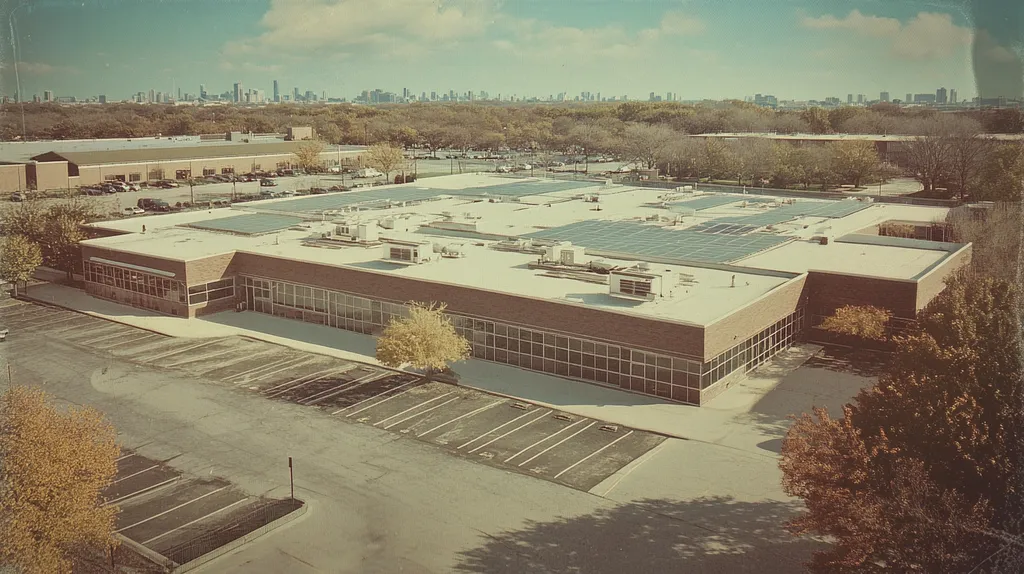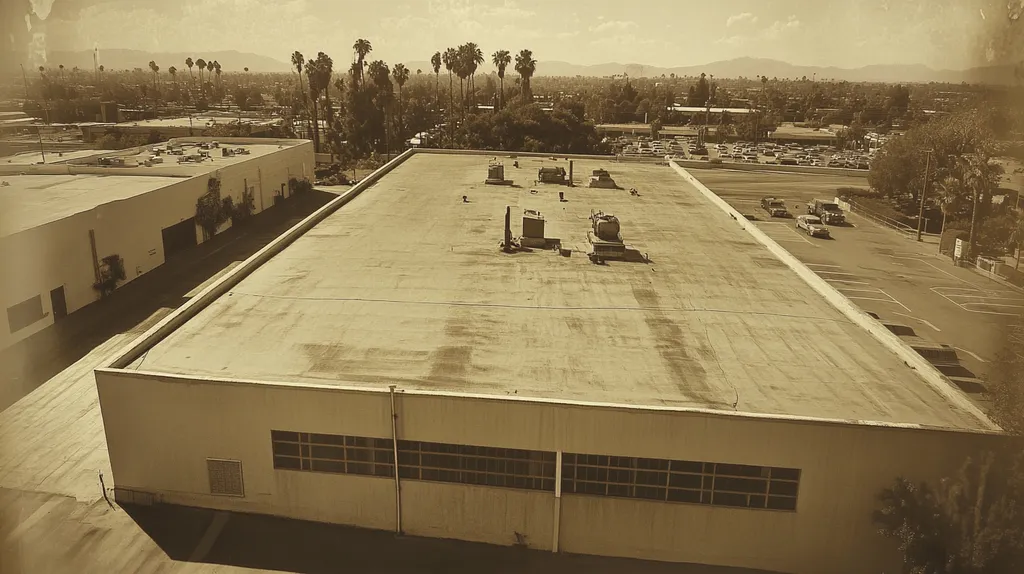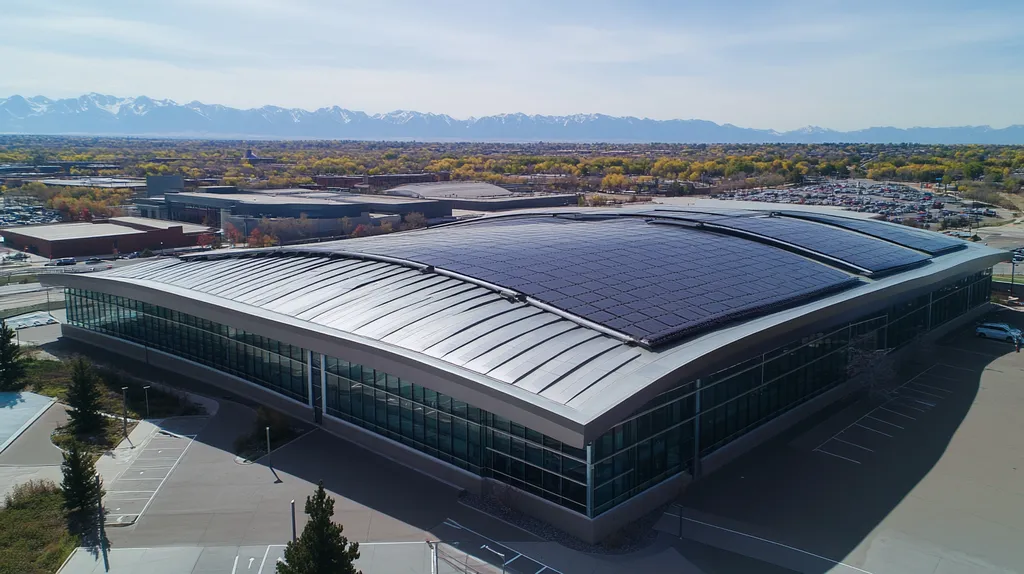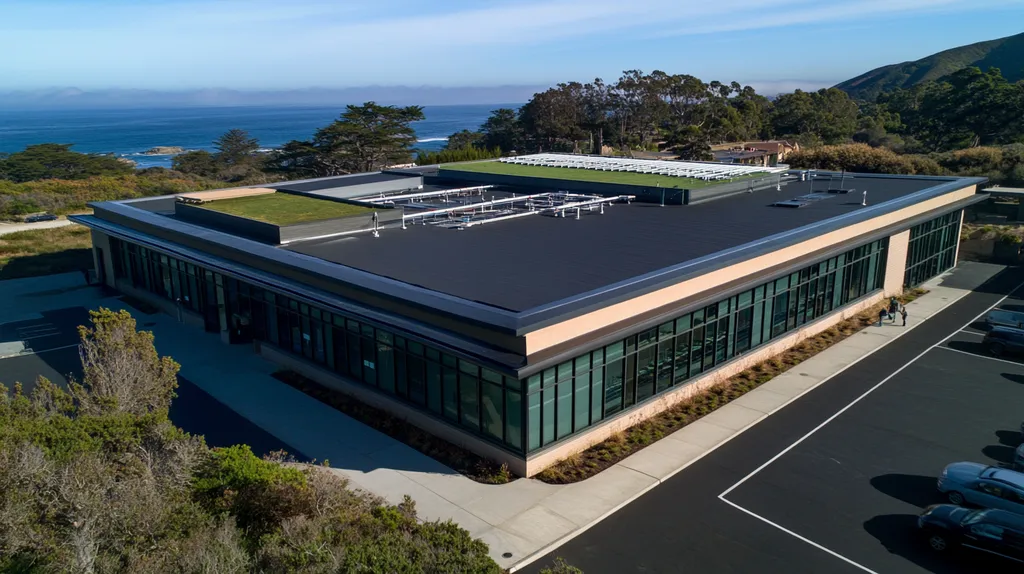With solar installations on commercial buildings projected to triple by 2030, property owners face a critical challenge: managing maintenance costs effectively. Industry data reveals that poorly maintained solar systems can decrease energy output by up to 30% while increasing operational expenses by 25%.
For industrial facilities in particular, the stakes are especially high. The larger scale of these installations magnifies both the potential savings and risks.
This comprehensive guide examines the specific maintenance cost considerations for solar installations on industrial roofs compared to other building types, providing property managers with actionable insights for optimizing their solar investments.
SECTION 1: THE BASICS EXPLAINED
As the demand for renewable energy accelerates, many property owners are exploring solar installations on their rooftops. Understanding the associated maintenance costs is vital, especially for industrial buildings with tight operational budgets. Miscalculating these costs can result in budget overruns and unexpected disruption to business operations. This section clarifies what solar maintenance entails, why it is critically important for industrial properties, and how the system functions effectively.
What It Is (In Plain Language)
Solar maintenance involves the regular activities necessary to ensure solar systems operate at peak efficiency. This includes cleaning solar panels, inspecting electrical components, and verifying the structural integrity of the installation. Each of these tasks is essential to maximizing energy production and preventing costly failures.
Particularly for industrial roofs, challenges like debris accumulation, leaks, or corrosion can significantly hinder solar efficiency. Routine maintenance helps detect and address these risks before they escalate into expensive problems.
In essence, effective solar maintenance is not merely about keeping the system clean; it is a strategic approach to enhance long-term return on investment while advancing sustainability objectives.
Why It Matters (To Your Building)
Recognizing solar maintenance costs is especially critical for industrial properties. These facilities often have larger systems and operate under specific demands. A properly maintained solar installation can lead to substantial energy savings.
Neglecting the upkeep of solar panels can result in diminished efficiency, leading to lost savings and higher energy costs. A straightforward inspection can catch minor issues before they develop into major repairs, saving significant amounts in the long run.
Moreover, maintaining optimal conditions for solar installations can improve a building’s overall value, making it a strategic investment for future growth and sustainability efforts.
How It Works
The maintenance of solar systems generally follows a structured protocol. Initially, a comprehensive inspection is performed to pinpoint potential problem areas, which may include checking for dirt accumulation on panels or assessing wiring and connections.
Following this, cleaning procedures are implemented to maximize sunlight absorption. For industrial roofs often subject to dirt or environmental pollutants, this step is crucial for ensuring optimal performance. Maintenance schedules can be tailored to the specific environmental conditions surrounding the installation.
Additionally, proactive monitoring of systems is facilitated through software that tracks performance and energy output. This method enables facility managers to resolve minor issues before they evolve into more significant challenges.
SECTION 2: PRACTICAL APPLICATIONS
In an era where renewable energy is becoming increasingly vital, property owners must make informed choices about solar installations on industrial roofs. The consequences of poor maintenance can be significant, leading to inflated costs and decreased efficiency. Alarmingly, statistics reveal that over 30% of industrial solar systems encounter service interruptions due to inadequate maintenance practices. This section delves into the practical applications of solar maintenance, covering common uses, critical times for maintenance, and how solar systems integrate with existing roofing systems.
Common Uses & Examples
Solar systems installed on industrial roofs primarily serve the purpose of energy generation, which can significantly curtail utility expenses. They are commonly utilized to power manufacturing facilities or to provide grid support during peak energy demand. The performance of these systems directly relies on diligent maintenance.
For instance, a well-maintained solar array at a manufacturing plant can lead to annual energy cost savings that can reach thousands of dollars. Conversely, neglecting regular maintenance checks can lead to degradation of solar panels, resulting in diminished energy output and financial drawbacks.
Additionally, roofs equipped with solar panels can function in stormwater management by capturing and directing rainwater runoff. This dual purpose highlights the need for meticulous maintenance to avert blockages that could jeopardize roofing integrity and functionality.
A proactive maintenance plan can pinpoint issues like dirt buildup on the panels, which may decrease energy efficiency by up to 20%. Regular inspections not only maximize energy savings but also extend the lifespan of the roofing system.
When You Need It Most
Timely maintenance is particularly essential during seasonal changes, especially in areas prone to extreme weather conditions. High winds, heavy snow, and excessive heat can all impact the structural integrity of solar installations. Addressing potential vulnerabilities quickly is crucial to prevent long-term damage.
Furthermore, a routine maintenance schedule should be established at least twice a year. This practice helps mitigate minor issues before they escalate into costly repairs. Monitoring performance trends can also unveil potential concerns before they hinder system efficiency.
Maintenance becomes even more critical following extreme weather events. Roofs may incur hidden damages that impact solar panel installations, requiring immediate inspection to ensure continued operational effectiveness. Overlooking these signs can lead to significant disruptions in energy production.
Recognizing the ideal times for inspections and maintenance is key to ensuring solar systems perform optimally throughout their lifecycle. Prepared property owners can evade unforeseen expenses and maintain uninterrupted energy output.
Interactions With Other Systems
The integration of solar panels with existing roofing systems creates complexities that necessitate careful management. Solar installations can influence critical aspects such as roof ventilation and drainage systems. Proper design considerations are important to prevent water pooling, which can lead to leaks and other structural issues.
Additionally, the electrical systems must be fine-tuned to accommodate the introduction of solar technology. Ignoring these interactions can lead to voltage discrepancies that could adversely affect both the solar arrays and the building’s electrical infrastructure.
Collaboration between roofing contractors and solar installers is vital. This synergy helps avert costly oversights and establishes effective maintenance protocols. Consistent communication among maintenance teams ensures that all systems remain compatible and functional.
Understanding the interactions between solar systems and other building systems enhances the overall reliability of the installation. A comprehensive maintenance strategy that looks at these relationships can extend system longevity and improve return on investment.
SECTION 3: KEY TERMINOLOGY DECODED
Understanding key terminology in solar maintenance is not just beneficial—it’s essential for property owners and facility managers. Misinterpretations can lead to costly decisions and inefficient systems that hinder budget goals. For example, distinguishing between “scheduled maintenance” and “emergency repairs” is crucial for effective budget allocation. This section decodes common terms, equipping stakeholders with the knowledge required to comprehend maintenance costs for industrial roofs in comparison to other structures.
Essential Terms Explained
In solar maintenance, understanding terms like “photovoltaic (PV) systems” and “inverters” is crucial. PV systems transform sunlight into electricity, while inverters convert this electricity into usable power for your facility. Familiarity with these concepts aids in pinpointing maintenance needs. A failure of an inverter, for instance, can drastically reduce energy production and inflate costs.
“Maintenance windows” are also vital—these are designated times when maintenance can be conducted without disrupting daily operations. Recognizing these windows helps optimize uptime and minimize unexpected expenses, ultimately improving long-term budget management for solar installations.
Another important term is “warranty terms,” which outline coverage for repairs and replacements. Knowing the specifics of warranties empowers property managers to plan financially, shielding them from unanticipated repair costs.
Ultimately, mastering these key terms enhances conversations with contractors and service providers, facilitating more strategic maintenance decisions that align with budgetary constraints and operational goals.
Industry Jargon Translated
Industry jargon can often create barriers to understanding. For instance, “O&M” stands for Operations and Maintenance—practices vital for ensuring solar systems run efficiently. The implications of O&M practices directly affect maintenance costs. A misunderstanding here could lead to inadequate service, thereby compromising energy output.
“Module cleaning” is another crucial term; it refers to cleaning solar panels to maintain optimal efficiency. Accumulations of dust, debris, and grime can significantly reduce energy production, increasing operational costs. By translating such jargon, property owners gain clarity on the necessity and frequency of these maintenance activities.
When facility managers demystify such jargon, they are better positioned to evaluate proposals and maintenance plans, ensuring alignment with operational requirements and financial limits.
Measurement & Units Simplified
Grasping measurement units in solar maintenance is critical for budgeting and planning. Energy output is primarily measured in kilowatts (kW) and kilowatt-hours (kWh). Familiarity with these units enables analysis of energy consumption and comparisons of solar production against operational requirements.
“Megawatt” (MW) is another key unit, especially relevant for larger solar installations. Understanding how these units interplay can clarify energy costs and the benefits of scaling systems for industrial roofs as opposed to smaller buildings.
Maintenance costs are often articulated in terms of “cost per watt” or “cost per kWh.” Recognizing these metrics empowers property owners to evaluate the return on investment for maintenance services, ensuring that every dollar spent translates into increased energy efficiency.
By simplifying these measurements, facility managers enhance their decision-making capabilities regarding maintenance, positively contributing to the overall financial health of their solar systems.
SECTION 4: DECISION FACTORS
As property owners contemplate solar installation on industrial roofs, they face critical decision factors that directly influence performance and costs. Striking a balance between upfront expenses and potential long-term savings is essential. Understanding the intricacies of maintenance costs becomes even more important when comparing industrial roofing systems to commercial flat roofs. Making decisions without complete information can lead to overspending and reduced efficiency.
Cost Considerations
Maintenance expenses rank high on the list of concerns when evaluating solar installations on industrial roofs. These costs can vary widely, depending on the roofing material and the complexity of the solar array. For instance, a flat, single-ply membrane roof generally presents lower maintenance costs compared to a built-up roof with multiple layers.
Additionally, some roofing types may require specialized equipment for servicing solar panels, leading to increased labor costs. This contrasts with conventional roofs, where maintenance tasks are often more straightforward. Recognizing these dynamics is vital for property owners when planning budgets effectively.
Caution is warranted regarding the potential for escalating repair costs over time. Industrial roofs that experience heavy foot traffic during solar panel maintenance may incur more wear and tear, necessitating more frequent repairs and associated costs.
Ultimately, understanding the long-term financial implications of solar maintenance facilitates more effective planning and resource allocation, helping to mitigate unexpected maintenance expenses.
Performance Trade-offs
Performance trade-offs are crucial when making decisions about solar systems on industrial roofs. The material of the roofing system directly influences the efficiency of the solar array. For example, a roof with reflective properties can enhance solar energy generation by minimizing heat absorption.
Conversely, the integration of solar systems on unsuitable roofing materials can limit their effectiveness. Increased moisture levels in certain roofing types can lead to reduced solar panel performance, possibly resulting in more frequent and costly maintenance interventions.
Understanding these performance factors can empower property owners to choose roofing solutions optimized for solar applications. An informed selection can significantly enhance energy yield, positively affecting the overall return on investment.
Finding the right balance between cost and performance is crucial. Decisions driven solely by initial costs may compromise energy efficiency, resulting in regrettable trade-offs. Owners must weigh both immediate and long-term savings when considering options.
Lifespan & Durability Factors
The lifespan and durability of both roofing and solar systems are key considerations affecting investment strategies. Industrial roofs are often designed with longevity in mind, but their compatibility with solar installations can play a critical role in overall durability and maintenance requirements.
A robust roof can provide a reliable platform for solar panels, reducing the frequency of repairs and replacements. In contrast, a less durable roofing system may deteriorate more quickly, necessitating increased maintenance that drives up overall costs.
Solar panel installations can impose additional stress on roofing systems. Therefore, it is essential to select materials capable of withstanding increased loads while allowing for the necessary expansion and contraction.
Finally, a commitment to rigorous maintenance can extend the lifespan of both the roof and the solar installation. Decisions made today should prioritize long-term durability, ensuring both systems remain cost-effective and functional for years to come.
SECTION 5: COMMON CHALLENGES
The integration of solar panels on industrial roofs is essential for maximizing efficiency and managing costs. However, property owners face distinct challenges that can substantially influence maintenance expenses. Industry data indicates that nearly 40% of solar installations encounter operational issues, leading to soaring maintenance costs. By identifying and addressing these common challenges, owners can safeguard their investments and leverage long-term operational benefits.
Frequent Problems & Solutions
Several persistent challenges can arise with solar panels installed on industrial roofs. Common issues include leaks stemming from improper panel installation and the accumulation of debris that hinders efficiency. Swiftly addressing these problems can mitigate extensive damage to both the solar system and the underlying roof structure.
Conducting regular inspections is paramount. These assessments help identify early warning signs, such as water pooling or shifted panels. Establishing a preventative maintenance schedule can not only reduce emergency repairs but also significantly extend the lifespan of the solar panels.
In certain situations, incorporating additional protective barriers can help shield the solar panels from physical damage caused by equipment or foot traffic. Proper training for maintenance staff on safely handling solar panels is also vital to minimizing human error.
Involving specialized contractors who possess expertise in both roofing and solar technologies can streamline troubleshooting processes. This dual knowledge is essential for developing effective long-term solutions to the challenges posed by solar installations.
Warning Signs To Watch For
Property managers must remain vigilant for warning signs that could indicate potential issues with solar installations. Unexplained drops in energy output or visible damage to the panels are key indicators that require immediate investigation.
Additionally, water stains or leaks in areas beneath solar panels may signify problems with the roof’s integrity. Neglecting these signs can result in costly repairs and deteriorate solar efficiency. Daily operational checks should include both energy production monitoring and assessing the physical condition of panels.
Facilities should also monitor their surrounding environment for excessive debris, such as leaves or snow buildup, that could obstruct sunlight and compromise performance. Implementing regular cleaning schedules can substantially enhance energy output while reducing maintenance costs.
Lastly, tracking fluctuations in temperature and monitoring shading on the panels can help to identify performance setbacks linked to environmental factors. Regular assessments of these conditions can prevent more severe complications down the line.
Preventative Approaches
Proactive maintenance strategies are critical for controlling costs associated with solar systems on industrial roofs. Establishing routine inspection schedules leads to timely repairs, minimizing the need for emergency interventions. This systematic approach ensures that potential issues are addressed before they escalate into significant financial burdens.
Incorporating advanced technologies, such as drones for aerial inspections, provides efficient monitoring of expansive roof areas. This method not only saves time but also enhances accuracy in detecting issues that may not be noticeable from the ground.
Training personnel in standard maintenance practices significantly reduces expenses and boosts system efficiency. Ensuring staff are well-versed in solar technology and its interaction with the roofing system promotes informed decision-making.
Furthermore, organizing regular training sessions with industry professionals enhances the understanding of best maintenance practices. This knowledge is vital for maintaining roof integrity while optimizing solar panel performance.
SECTION 6: NEXT STEPS & RESOURCES
As solar panels become more commonplace on industrial roofs, understanding their maintenance costs is imperative for long-term success. A recent study highlighted that poorly maintained solar systems can increase operational costs by up to 25%. For commercial property owners and facilities managers, navigating the complexities of solar maintenance is crucial. By asking the right questions and utilizing trusted resources, owners can optimize their investments and enhance financial performance.
Questions To Ask Providers
When assessing solar providers, it is vital to pose specific questions regarding maintenance costs. Begin by inquiring about their maintenance packages, including which services are provided. Understanding if routine inspections and cleaning are included can impact budgeting significantly.
Additionally, ask how they monitor and report maintenance issues. Effective communication can help prevent small concerns from escalating into larger, more expensive repairs. Questions about warranty coverage and response times are essential for ensuring prompt service.
It’s also crucial to clarify whether the provider adopts a proactive or reactive maintenance approach. A focus on preventative care can reduce costs by addressing potential issues early.
Finally, assess their experience with industrial roofs. Providers with a background in similar environments are more likely to understand the unique challenges that come with large-scale solar installations.
Industry Standards & Guidelines
Becoming familiar with industry standards can aid in making informed decisions regarding solar maintenance. The National Renewable Energy Laboratory (NREL) offers guidelines that ensure solar installations meet established safety and efficiency standards.
Certifications from credible organizations, such as the North American Board of Certified Energy Practitioners (NABCEP), reflect a provider’s dedication to quality. Such certifications help protect investments through consistent performance assurance.
Regular reports from industry entities can offer benchmarks for typical maintenance expenses. By comparing their maintenance costs against these benchmarks, property owners can identify areas needing attention.
Furthermore, understanding local regulations regarding solar maintenance is crucial. Adhering to these guidelines helps avoid fines and ensures operational efficiency.
Further Learning Simplified
Numerous resources are available to enhance knowledge of solar maintenance. Webinars and online courses offer insights into best practices and the latest advancements in solar technologies.
Industry publications, like Solar Industry Magazine, frequently publish articles and case studies detailing effective maintenance strategies. These resources are valuable in identifying common challenges and successful methodologies.
Networking events and trade shows provide opportunities to connect with fellow professionals, leading to shared experiences and solutions related to maintenance hurdles.
Finally, engaging in online forums and community groups focused on solar energy can foster discussion and yield firsthand accounts of maintenance requirements and solutions. Active participation in these communities helps stakeholders stay informed about new developments in the sector.
The Bottom Line
With solar maintenance costs projected to impact over $50 billion in commercial installations by 2030, property owners must act strategically to protect their investments.
The data clearly demonstrates that industrial roofs face unique challenges that can increase maintenance expenses by 25-40% compared to other building types when proper protocols are not followed.
However, implementing robust maintenance programs can reduce these costs by up to 30% while extending system lifespan by 5-10 years.
The key to success lies in understanding the specific maintenance requirements of industrial installations, selecting qualified providers, and following established industry guidelines.
As solar adoption accelerates, those who master these maintenance fundamentals will achieve superior returns on their renewable energy investments.
FREQUENTLY ASKED QUESTIONS
Q. What are maintenance costs for solar on commercial roofs?
A. Maintenance costs for solar systems on commercial roofs can vary widely. Factors include roof type, environmental conditions, and installation complexity. Understanding these elements can help property owners budget effectively and ensure optimal system performance.
Q. Why are maintenance costs higher for industrial roofs?
A. Maintenance costs tend to be higher for industrial roofs due to their larger size and complex installation requirements. Additionally, harsh environments and more significant wear and tear increase the need for specialized maintenance and repairs, thereby inflating overall costs.
Q. What maintenance tasks are essential for solar on industrial roofs?
A. Essential maintenance tasks include panel cleaning, electrical inspections, and checking structural integrity. Regular assessments help identify potential issues early and ensure the solar system performs optimally, thus maximizing energy output and minimizing unnecessary expenditures.
Q. How often should solar systems on industrial roofs be maintained?
A. Solar systems should ideally be maintained biannually, with additional checks after severe weather. Frequent inspections allow for early detection of potential issues, ensuring consistent energy production and reducing the risk of costly repairs over time.
Q. What are common challenges with solar on industrial roofs?
A. Common challenges include debris accumulation, leaks, and improper installations. These issues can severely impact efficiency and lead to increased repair costs if not addressed promptly, making regular maintenance crucial for optimal system performance.
Q. What should I ask solar maintenance providers?
A. Inquire about maintenance packages offered, response times for issues, and monitoring methods. Clear communication on services provided can prevent minor issues from escalating, thus protecting your investment and ensuring efficient operation of the solar system.
Q. What are the long-term benefits of proper solar maintenance?
A. Proper maintenance enhances performance, extends the lifespan of solar systems, and reduces operational costs. It also allows property owners to maximize energy savings and uphold the integrity of the roofing system, thereby ensuring a solid return on investment.











